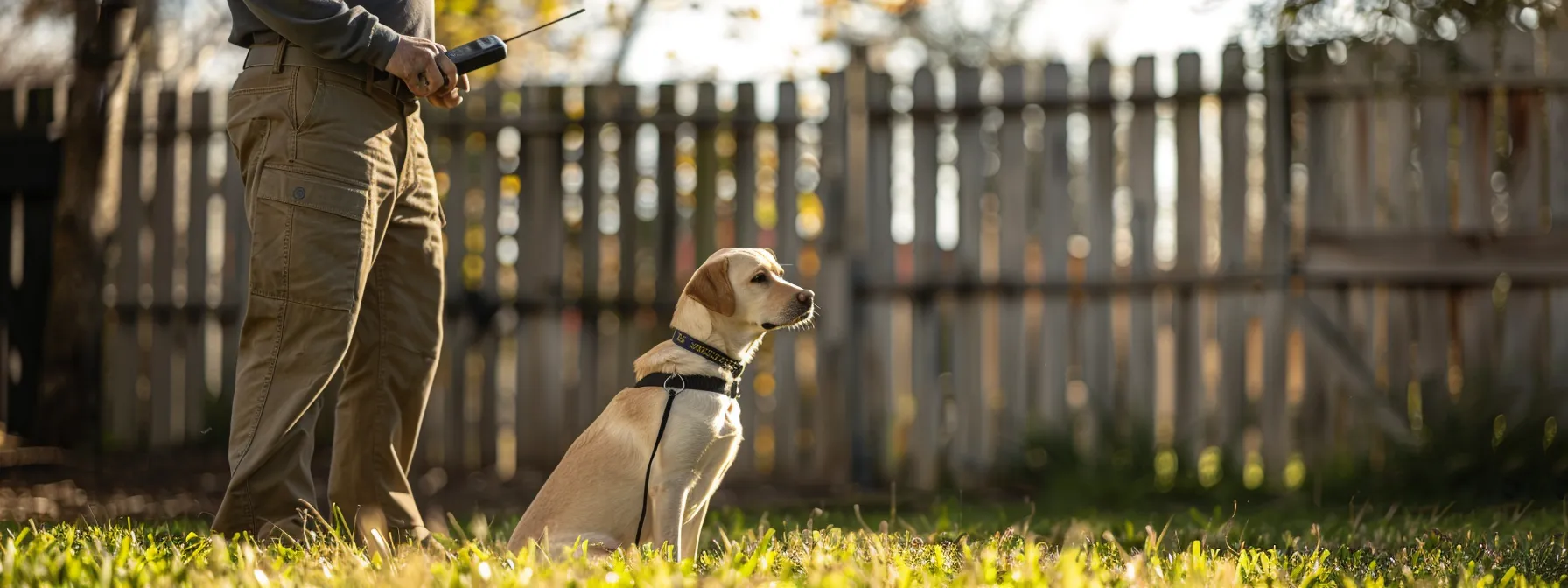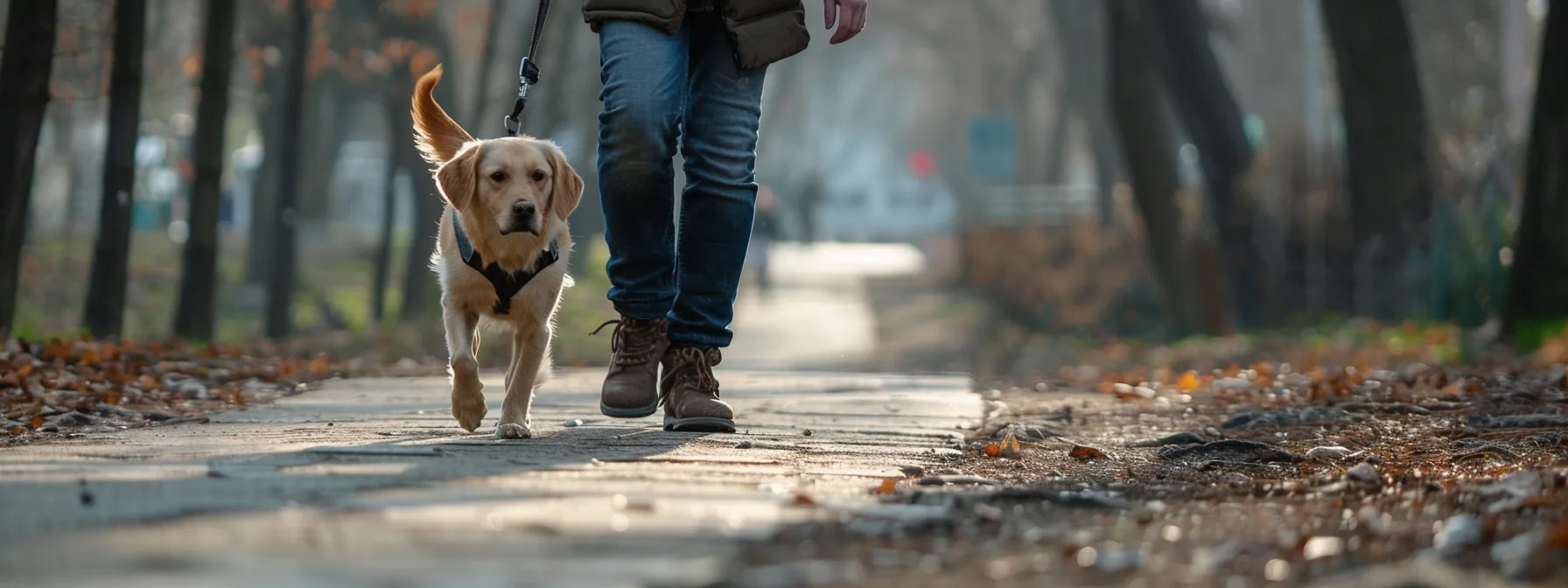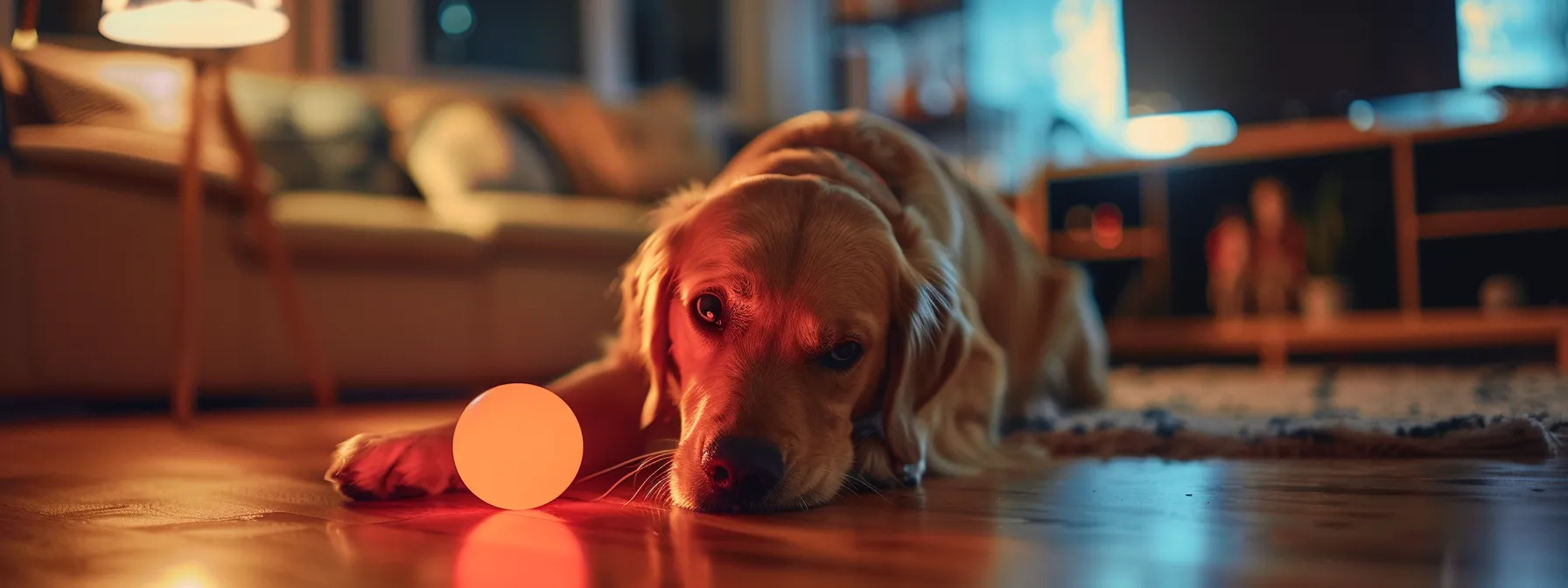Transforming Animal Behavior: Innovative Gadgets for Pet Training
Dog owners often face challenges in training their beloved pets, searching for the perfect balance of firmness and affection. Innovative gadgets have flooded the market, ranging from advanced dog collars employing ultrasound to curb unwanted barking, to leashes and collars that aid in teaching dogs to walk without pulling. At the heart of successful dog training lies the integration of these tools, seamlessly blending technology with traditional methods. Every pet parent yearns for a well-mannered canine companion, and the right gadget can make this goal attainable. Keep reading to discover how these groundbreaking devices can transform your dog training endeavors into a successful journey.
Discover the Latest Gadgets for Effective Pet Training

The landscape of pet training is undergoing a significant transformation with the advent of technology-infused tools. Discarding obsolete techniques, modern gadgets now offer more humane methods for teaching desired behavior, providing both pets and their owners with a positive reinforcement experience. As shock collars become a topic of contentious debate, alternative devices surge in popularity, demonstrating that efficiency need not come at the cost of a pet‘s well-being. This shift necessitates a deeper understanding of how technological advancements aid in shaping animal behavior more gentler and interactive ways. Pet owners who are keen to train their companions effectively must discern which electronic tools align best with their goals. In furnishing pets with the appropriate device, one must not only consider the pet‘s size and disposition but also the specific behavioral modifications desired. Consequently, selecting the right tool becomes as vital to the process as the training itself.
Understanding How Technology Is Shaping Pet Training
With the integration of technology in animal training, traditional methods are rapidly being supplanted by advanced alternatives. These innovations span from toys that emit interactive vibrations to entice and retain animal attention, to sophisticated carts that trainers can control remotely to simulate real-world scenarios.
Advertising plays a pivotal role in revealing the capabilities of these modern gadgets, showcasing how such devices can simplify and enrich the training process. It casts light on their features, which are designed to appeal to the animal‘s instinctual behaviors, thus making training sessions more engaging and productive.
- Technological advancements introduce interactive and engaging tools for animal training.
- Advertising highlights features that align with natural animal behaviors for enhanced training methods.
The Benefits of Using Modern Gadgets Over Traditional Methods
Clicker training exemplifies the innovative approach that modern gadgets offer, moving beyond punitive methods to create positive associations for pets. This technique, facilitated by a small, hand-held device, enables precise timing in signaling reinforcement for desired behaviors, thus accelerating the learning process. Unlike traditional scolding, this method fosters trust and a stronger bond between pet and owner.
Manufacturers are now focusing on creating brands that address specific behavioral concerns such as excessive barking or anxiety. These modern gadgets are tailored to mitigate stressors that prompt undesirable reactions in pets, employing gentle vibrations or sounds to distract and calm, rather than instilling fear. As a result, pets can achieve a more peaceful state of mind, aligning their behavior with their owners’ expectations more readily.
Tips for Choosing the Right Device for Your Pet
Selecting the right pet training device often requires a clear understanding of the gadget’s capability to utilize natural cues. For instance, a dog whistle operates at a frequency mainly perceptible to canines, leveraging sound to guide behavior without causing unnecessary pressure on the animal. Acknowledging this capacity for targeted communication ensures the tool selected is as effective as it is considerate of the pet‘s sensory experience.
Moreover, pet owners who prioritize outdoor safety may find devices equipped with a global positioning system indispensable. These gadgets not only train pets in boundaries and allowable distances but also protect them from straying too far. They achieve this without needing to apply restraint around the neck, instead providing gentle alerts to both owner and pet, ensuring guidance is always at hand.
The journey to a well-behaved pet begins now. Unlock your dog’s potential with the newest innovations in training tools.
Enhance Your Dog’s Behavior With Innovative Training Tools

In the contiguous United States, pet owners grapple with common behavioral challenges, such as separation anxiety in dogs, which can lead to incessant barking and even aggression. Addressing these behaviors is imperative, not only for the tranquility of the home environment but also to prevent disturbances that can occur with events like package delivery. The emergence of a myriad of training devices promises relief, providing solutions that range from specially designed collars to ultrasonic deterrents. This discussion will offer a detailed breakdown of the top devices on the market, effectively contrasting the merits of training collars against the non-invasive approach of ultrasonic tools. Furthermore, the conversation will extend to practical strategies for pet owners, outlining how to incorporate these gadgets seamlessly into daily routines for more harmonious living with their pets, be it a barking dog or a mischievous kitten. Remote control functionality adds convenience and precision to training, empowering owners to adjust settings and stimuli in response to their pets’ immediate behaviors from afar.
Breakdown of the Top Devices for Reducing Barking and Aggression
As pet owners seek effective tools for curbing unwanted barking and aggression, the focus shifts to gadgets that employ technology rather than pain or punishment. Innovative collars use a combination of sound, vibration, and scent to redirect a dog’s behavior, associating these signals with quiet and calm without compromising their health or well-being.
- Sound-emitting devices, often likened to a bird‘s call, gently capture a dog’s attention and interrupt their barking cycle.
- Vibration collars provide a harmless signal that refocuses the dog away from aggressive actions.
- Scent-based tools release a soothing aroma when the dog exhibits undesired behavior, promoting relaxation.
Implementing training tools should also involve a behavior reinforcement plan that aligns with the animal‘s natural instincts and health needs. With advancements in device programming, including javascript-based applications, owners are now equipped to customize training sessions, ensuring that stimuli remain within a safe threshold and contribute to a positive training experience.
Training Collars vs. Ultrasonic Deterrents: What Works Better?
The debate between training collars and ultrasonic deterrents is a significant one among pet owners. For puppy caretakers, especially of breeds like the golden retriever, known for their energy and occasional stubbornness, the right choice is crucial. Training collars can offer immediate feedback through a button, while ultrasonic deterrents interact with the pet more passively, often as a response to excessive barking.
On the other hand, ultrasonic deterrents, which require no physical contact with the puppy‘s neck, promise a less confrontational methodology. The mat-style deterrents emit a sound inaudible to most humans but captures a dog’s attention, effectively teaching them quiet behavior through sound association without causing discomfort or confusion.
| Feature | Training Collars | Ultrasonic Deterrents |
|---|---|---|
| Feedback | Direct and adjustable via a button | Automatic and sound-based |
| Target Behavior | Various, including aggression and barking | Primarily focused on barking reduction |
| User Interaction | Active participation required for effectiveness | Passive; works autonomously once activated |
| Suitability | Can be tailored to different breeds and sizes | One-size-fits-all solution |
| FAQ and Support | Often comes with comprehensive guides | May have limited troubleshooting resources |
How to Integrate Gadgets Into Your Daily Training Routine
Introducing gadgets into the daily routine of a German Shepherd requires a nuanced approach, focusing on consistency without inducing fear or aggression. For this intelligent and responsive dog breed, the frequency and timing of gadget use must complement their training sessions, allowing for the gradual replacement of aversives with positive, technology-based stimuli.
Pet owners might consider incorporating gadget engagement into their German Shepherd‘s regular activities, effortlessly merging training with playtime or obedience practice. This approach minimizes stress for the dog while simultaneously reinforcing desired behaviors, ultimately aiming to establish trust rather than reliance on fear-driven tactics.
Moving from basic commands to advanced obedience, innovative training tools pave the way. Next, discover the impact of the long-distance dog shock collar on refining your pet‘s behavior.
The Revolutionary Dog Shock Collar for Long-Distance Training

In the domain of pet training, shock collars represent a contentious yet potentially transformative technology, particularly where distance poses a challenge. Labrador retriever owners, for example, might seek a device that ensures their pet remains within the safety of a predefined fence boundary. When considering an effective shock collar, several features stand paramount: precise frequency control, a reliable range that accommodates the energy and agility of active breeds, and an incorporated camera for real-time monitoring. While the term ‘shock collar‘ may evoke concern over potential torture, modern iterations of these devices focus emphatically on safety and comfort, employing adjustable stimulus levels to educate rather than punish. The subsequent discussion pivots to compare top models that excel in functional range and depend in order to ascertain optimal models that prioritize pet welfare alongside training efficiency.
Features to Look for in an Effective Shock Collar
An effective shock collar stands as a pivotal component among the array of training tools available to pet owners, offering a means to instruct pets on safe boundaries, despite the obstacle of distance that remains invisible to the naked eye. Such collars should be equipped with a precise and humane level of static correction to signal to pets without causing undue stress or discomfort.
Integrating ultrasonic features into these devices enhances their effectiveness, providing an extra layer of communication with pets through high-frequency sound waves that are inaudible to humans. The ideal shock collar combines these ultrasonic capabilities with robust construction and a user-friendly interface, ensuring durability and ease of use in various training environments.
Ensuring Safety and Comfort: Guidelines for Use
Ensuring the welfare of a pet during electronic training mandates adherence to proper guidelines, especially when implementing stimulation through a dog shock collar. It is paramount to start at the lowest level of correction, observing the pet‘s response to ensure it is both effective and devoid of distress, thus maintaining the pet‘s comfort and safety throughout the training process.
Prior to shipping a new electronic training device to a client, responsible retailers often include educational media that provides clear instructions on gradual implementation. This gesture serves as a treat for pet owners, equipping them with the knowledge necessary to foster a positive learning environment, thereby enhancing the bond between the owner and their animal companion.
Comparing Top Models for Range and Reliability
In an effort to sidestep the risks of learned helplessness associated with poorly implemented training, the latest dog shock collars interface seamlessly with a user’s smartphone. This synergy affords owners the opportunity to meticulously track data on their retriever’s behavior, enhancing the precision of remote training while ensuring the dog remains engaged in its exercise regimen.
Range and reliability distinguish the elite models from their inferior counterparts; the best devices offer extensive coverage capable of maintaining a consistent connection, even in areas where a retriever roams freely. Such robust performance is a testament to the manufacturers’ commitment to delivering tools that support persistent and reliable communication between pet and owner, thereby improving the overall training experience.
Shifting gears from remote collars, pet owners are now discovering the simplicity of training clickers. This method reshapes the way we communicate, creating a language of clicks that dogs instinctively follow.
Transforming Communication With Pet Training Clickers

Shifting the paradigm of pet training, clicker training emerges as a science-backed technique that capitalizes on positive reinforcement. By employing a small, hand-held device that produces a distinct click sound, pet owners can precisely mark the moment an animal performs a desired behavior, thereby facilitating faster learning and reinforcing the behavior mentally. The sound of the clicker acts as a bridging stimulus, a communicative tool that perfectly captures the instance of compliance before the reward is given, forging a powerful link between action and incentive. Addressing the diverse needs of pet trainers, the market offers a variety of clickers suitable for dogs, cats, and even exotic pets, reflecting an emphasis on versatility and cross-species effectiveness of this method. This subsection delves into the cognitive mechanics that render clicker training an exceptional method, outlines the most practical approach for integrating clickers into daily training routines, and provides recommendations for selecting the best clicker tailored to an array of pets with differing needs.
The Science Behind Clicker Training and Positive Reinforcement
Clicker training hinges on the scientific principle of operant conditioning, which posits that behaviors followed by rewards are more likely to recur. By using a clicker to produce a distinct sound at the precise moment an animal performs the desired behavior, trainers facilitate clear communication. This sound, contingent upon actions that earn rewards, becomes an effective bridge between command and reward, reinforcing behavior quickly and successfully.
Positive reinforcement, as a component of clicker training, supports and strengthens the desired behavior without inducing fear or discomfort. This method, in contrast with aversive control techniques, fosters an environment of trust and eagerness to learn. Animal trainers widely acknowledge the efficacy of positive reinforcement in promoting behavioral consistency and enhancing the bond between pets and their owners.
| Principle | Method | Outcome |
|---|---|---|
| Operant Conditioning | Clicker Training | Behavioral Reinforcement |
| Incentive Association | Positive Reinforcement | Trust and Consistency |
Step-by-Step Guide to Introducing a Clicker to Your Training Sessions
Introducing a clicker into pet training sessions begins with creating an association between the clicking sound and a positive experience for the animal. To establish this connection, the trainer should press the clicker at the exact moment the pet performs the desired action, immediately followed by a reward such as a treat or affectionate praise.
Consistency is the key to successfully embedding this new element into regular training routines. It is important to use the clicker consistently whenever the pet exhibits the correct behavior, ensuring the animal understands that the clicking sound is a marker of good behavior and the precursor to a reward:
- Start by pressing the clicker and offering a treat immediately afterwards, without requiring any specific behavior from the pet.
- Once the pet shows interest in the click sound, introduce simple commands and use the clicker to mark the exact moment the desired action is performed.
- Gradually increase the complexity of commands as the pet becomes more responsive to the clicker, making sure to consistently use the click to signify correct behavior followed by rewards.
Recommended Clickers for Dogs, Cats, and Other Pets
Market shelves brim with an array of clickers suited to the distinct needs of various pets, each designed to enhance the communication between animals and their trainers. For canine enthusiasts, ergonomically designed clickers offer ease of use, crucial for maintaining focus during training sessions, while cat trainers might opt for clickers with softer tones to match the sensitivity of felines’ hearing.
Reflecting the versatility of these devices, several clickers come equipped with additional features such as adjustable volume control or integrated lights, broadening their applicability to suit a diverse range of animals, from the standard household dog to the more exotic pet varieties. This adaptability ensures that all pets, regardless of species or disposition, can benefit from the clear and consistent training messages these clickers are designed to convey.
Pet training clickers revolutionize how owners interact with their furry companions, building a bridge of understanding through the power of positive reinforcement. Now, let’s turn our attention to ultrasonic devices, where cutting-edge technology offers a humane solution for managing excessive barking without a word spoken.
Ultrasonic Devices: A Humane Alternative to Stop Barking

The intersection of technology and animal behavior has led to the development of ultrasonic devices, tools that offer pet owners a non-intrusive method to discourage their pets’ undesirable habits. These devices emit sounds at frequencies higher than the human hearing threshold but well within a dog’s range; these frequencies are meant to gently interrupt and modify behaviors such as excessive barking. The effectiveness of these tools relies heavily on their strategic placement within the pet‘s environment and adjustment of settings tailored to each individual animal‘s sensitivity. With a range of models available for both indoor and outdoor scenarios, pet owners are presented with options to address their specific needs. This subsection delves into how ultrasonic devices provide a compassionate solution for behavior modification, the critical considerations for deploying them effectively around one’s space, and evaluates the features of leading products catering to various environments where pets reside.
How Ultrasonic Devices Deter Unwanted Behavior
Ultrasonic devices offer a discreet yet effective method for deterring disruptive behaviors such as incessant barking by emitting a high-frequency sound that captures a dog’s attention and interrupts the behavior without harm. These devices activate when barking is detected, releasing the sound that is distressing to dogs but typically unheard by humans, making it a peaceful solution for the household.
The success of ultrasonic devices in modifying behavior lies in their ability to consistently associate the unpleasant sound with barking, which encourages dogs to avoid making noise to evade the ultrasonic tone. Owners report significant improvements in their pets’ behavior, as the animals learn to associate silence with the absence of the sound, thus promoting a quieter environment without the need for physical correction or reprimands.
Placement and Settings for Optimal Effectiveness
Securing the most advantageous position for an ultrasonic device within one’s home is mission-critical for its success in curbing unwanted barking. Placement at the dog’s level, in an unobstructed area where the dog frequents, maximizes the chances that the device’s emission will be within range to effectively deter the behavior.
Adjusting the sensitivity and range settings on the ultrasonic device is essential to tailor the deterrent effect to the dog’s hearing and the dimensions of the space. Careful calibration ensures that the device activates only in response to the dog’s barking, preventing desensitization to the ultrasonic noise and maintaining its effectiveness as a training tool.
Comparing Popular Ultrasonic Gadgets for Indoor and Outdoor Use
When evaluating ultrasonic devices designed for interior use, one notes a focus on device discreetness and aesthetic integration into the home environment. These units are often small, unobtrusive, and offer variable range settings to accommodate the acoustics of enclosed spaces.
Conversely, ultrasonic gadgets intended for outdoor use are constructed with durability to withstand the elements. They typically feature a more robust range and are engineered to cover larger areas, ensuring that the behavioral modification capabilities are not hindered by open spaces:
- Interior ultrasonic devices prioritize discreet design and adaptable range settings.
- Outdoor models emphasize extensive coverage and durability to resist weather conditions.
Ultrasonic devices offer a peaceful approach to silence barks. Now let’s tackle the challenge of teaching dogs to walk without pulling.
Innovative Solutions for Teaching Dogs Not to Pull

Transitioning into the realm of leash etiquette, the quest for a harmonious walk with one’s canine companion often leads to the consideration of specialized training accessories. No-pull harnesses and headcollars have surfaced as strategic implements, each engineered to discourage pulling by redirecting a dog’s movement. Mastery in leash training harnesses the potential of these devices, emphasizing technique to guide dogs towards desirable walking behaviors. Assessing the suitability of such products necessitates a focus on the specific requirements of various breeds and sizes, ensuring that the selected solution fosters comfort and compliance without hindering the dog’s natural gait or enthusiasm for exploration.
Exploring No-Pull Harnesses and Headcollars
No-pull harnesses offer a humane solution to the common problem of dogs that pull on their leash during walks. These devices work by distributing the pressure across the dog’s chest and back when they try to pull, reducing the strain on their neck and providing a more controlled walking experience.
Headcollars, on the other hand, function by gently redirecting the dog’s head and attention when they pull. This encourages the dog to focus on their owner and walk alongside them, which is instrumental in establishing good leash behavior over time.
| Device Type | Method of Control | Pressure Distribution | Suitable for Training |
|---|---|---|---|
| No-Pull Harness | Distributes pressure away from neck | Across chest and back | Yes |
| Headcollar | Redirects dog’s head | On head and muzzle | Yes |
Techniques for Successful Leash Training With These Devices
Embarking on leash training necessitates patience and a consistent regimen. Harnessing the efficacy of no-pull devices, trainers are encouraged to employ gentle guidance, utilizing the restraint offered by a harness as an opportunity to reinforce the command to ‘heel’, thereby steadily training the dog to remain at the owner’s side. Consistency in these practices solidifies the association between the devices and the desired walking behavior.
Success in leash training with headcollars involves acclimating the dog to the sensation of guidance around their head. Trainers should progressively introduce the headcollar during short walking sessions, praising calm behavior and gradually increasing the duration of use, which enables the animal to comfortably adapt to this form of direction without resistance or anxiety.
Assessing the Best Products for Different Breeds and Sizes
In the selection of appropriate training aids for canines, special attention should be directed toward the breed-specific characteristics and the individual’s size. Large breeds with substantial strength, such as the Bernese Mountain Dog, may necessitate robust no-pull harnesses with reinforced stitching and durable buckles, while diminutive breeds like the Chihuahua benefit from lightweight and snugly fitting gear that provides control without overwhelming their small frames.
For pet owners of mixed-breed dogs, adjustable products that can cater to a unique body shape are indispensable, ensuring a comfortable and secure fit. Moreover, as puppies grow, owners should seek training tools that can adapt to their changing size, thereby providing a reliable solution throughout the dog’s development into adulthood.
Smart collars are on the horizon, set to transform the landscape of pet health and training. Embracing advanced technology, these devices promise a new era of ease and effectiveness for dog owners.
Smart Collars: The Future of Pet Health and Training

The acceleration of technological integration into pet care heralds the arrival of smart collars, redefining the relationship between animals and their trainers. These multifaceted devices harness the power of GPS and activity monitoring to offer a panorama of an animal‘s daily routines, movements, and training progress. Beyond mere location tracking, they shine a light on canine behavior, distilling vast arrays of data into actionable insights that can fine-tune training strategies. As pet owners scrutinize the market for the best tools to support their animal‘s well-being, a selection of superior smart collars rises to prominence. They stand out not only for their connectivity and analytic prowess but also for their capacity to help guardians cultivate better habits, health, and harmony with their pets.
Integrating GPS and Activity Tracking for Comprehensive Training
Incorporating GPS and activity tracking in pet training collars provides owners with a level of understanding previously unattainable: insights into the pet‘s location and movements help create tailored training plans. Such collars record data on pets’ activity levels, enabling trainers to set measurable goals and observe trends over time.
| Function | Description | Impact on Training |
|---|---|---|
| GPS Tracking | Monitors pet location and movement patterns. | Enables precise training adjustments based on location-specific behavior. |
| Activity Monitoring | Logs daily exercise and rest periods. | Assists in setting health and behavior goals tailored to the pet’s activity levels. |
Active training reinforced by these advanced collars allows for a responsive approach, as owners can immediately address behavior related to specific places or levels of activity: A dog’s propensity to wander off or overexert during play can be managed more effectively with real-time data.
Analyzing Behavior Trends With Smart Technology
Smart technology collars are revolutionizing pet training by providing detailed analytics on animal behavior. By evaluating patterns in activity and rest, trainers can gain insights into a pet‘s temperament, potentially uncovering underlying factors contributing to behavior issues.
These gadgets enable a proactive approach to modifying animal actions, allowing trainers to cater to individual training needs. Real-time data and trend analysis inform trainers of the effectiveness of their methods, paving the way for optimized training regimens that are both humane and result-oriented.
Selection of the Best Smart Collars on the Market
In a burgeoning market for pet-centric technology, selecting the ideal smart collar requires assessing the unique relationship between functionality and ease of use. Savvy pet owners often favor collars that blend a sleek, unobstructive design with an intuitive app interface, ensuring the monitoring experience is stress-free and beneficial.
Market leaders in smart collar production distinguish themselves through exceptional battery life and robust waterproofing, traits that underpin the reliability and longevity of the device. These attributes are paramount for pet owners seeking the assurance that their companion’s safety and wellness are being monitored continuously, even in rigorous environments.
Harnessing technology to monitor pet health marks the start of an exciting evolution. Now, let’s focus on how advanced training mats revolutionize keeping paws off your favorite couch.
Advanced Training Mats: Keeping Pets Off Furniture

Within the realm of pet training, advanced training mats have surfaced as a practical solution to dissuade pets from climbing on furniture or engaging in undesirable scratching behaviors. These sophisticated mats leverage mild, deterring stimuli to teach pets which areas are off-limits, thus protecting home furnishings from damage. Educators and pet owners alike are now turning to these devices as a way to establish clear boundaries for pets in a safe and efficient manner. As this section unfolds, it will detail the operative mechanisms behind training mats, the strategic placements that maximize their deterrent effect, and an analysis of the products that excel in terms of safety and effectiveness for creating a well-ordered living space.
How Training Mats Discourage Climbing and Scratching
Training mats operate as a discrete but effective deterrent for pets who habitually climb on furniture or partake in undesired scratching. Imbedded with sensors, these mats detect the presence of a pet and emit a subtle, harmless static pulse that discourages the pet from remaining on the surface.
This method of behavior modification capitalizes on the principle of negative reinforcement; the mild discomfort leads the animal to associate the undesirable behavior with an unpleasant but safe sensation. Thus, pets quickly learn to avoid areas outfitted with these training mats, fostering better habits within the home environment.
- Training mats detect pet presence and deliver a harmless static correction.
- Pets learn to associate unwanted climbing and scratching with negative reinforcement.
Effective Placement and Training Tips
To ensure training mats function optimally, place them in areas where pets frequent or display inappropriate behavior: perching on armrests, clawing cushions, or approaching off-limits relics. Positioning these mats on or near the proscribed zones subtly informs pets of boundaries, redirecting their habits towards pet-friendly spaces.
For training mats to achieve the best results, pet owners should supplement the deterrent effect with consistent training cues. Regularly guiding pets to appropriate areas for play and rest, paired with these mats, solidifies their understanding of household rules and designates sanctioned spaces for activity.
| Consideration | Placement Strategy | Training Integration |
|---|---|---|
| Location | Install in pet-prevalent areas and near valuable furniture | Guide pets toward allowed areas with positive cues |
| Consistency | Keep the mats in place to maintain a clear boundary | Combine with regular, reinforced training instructions |
| Supplementary Actions | Position beside pet-friendly zones for clear spatial division | Affirm correct behavior with rewards away from the mats |
Review of Mats Designed for Safety and Efficiency
In assessing training mats that prioritize pet safety and the efficiency of the deterrent signal, one must scrutinize the mat‘s sensitivity options and adjustability. The leading products in this category offer a range of settings, from mild to more assertive stimuli, allowing pet owners to tailor the feedback to their pet‘s specific tolerance and learning speed.
Further distinguishing themselves, the safest and most efficient mats incorporate an auto-off feature that halts stimulus delivery after a brief period, thereby preventing over-correction and ensuring the pet‘s well-being. This attention to safeguarding pets underscores the manufacturers’ commitment to ethical training practices while promoting effective behavioral modification.
| Product Feature | Sensitivity Options | Auto-Off | Adjustable Settings |
|---|---|---|---|
| Leading Products | Multiple levels for animal tolerance | Integrated for safety | Customizable for tailored training |
Now that your pet respects the boundaries of home decor, ensure their safety during evening strolls. Light up your nighttime walks with versatile LED dog collars.
Enhance Nighttime Safety With LED Dog Collars

As pet owners strive to safeguard their furry companions during nocturnal escapades or in the dim light of dawn, the adoption of LED dog collars has become a pivotal safety measure. Empowering owners to drastically reduce the risk of accidents, these illuminated collars distinguish pets from their surroundings, allowing them to be easily spotted by passersby, cyclists, and motorists. Beyond the primary function of visibility, these advanced collars integrate features such as extended battery life and hard-wearing materials, providing long-lasting and reliable use. This exploration unveils an array of options for LED dog collars, emphasizing those that deliver on the promise of ensuring pets are conspicuous in any lighting condition, enhancing peace of mind for owners during outdoor activities.
Advantages of Using Light-Up Collars for Early Morning or Nighttime Walks
LED dog collars serve as a beacon of security for pets and owners alike during walks in low-light conditions. These illuminating accessories make animals highly visible, averting potential dangers by alerting motorists and pedestrians to their presence.
The implementation of light-up collars into a pet‘s wardrobe significantly mitigates the risks associated with early morning or evening strolls. By enhancing visibility, these collars contribute to a safer environment, allowing for tranquil and worry-free outings regardless of the time of day.
Features to Consider: Battery Life, Durability, and Visibility
When selecting an LED dog collar, the longevity of the battery is a fundamental consideration. Pet owners should seek out collars with long-lasting power sources to ensure consistent visibility throughout their walks without the need for frequent recharging or battery replacements.
Durability and visibility are equally paramount in an LED dog collar. Investors must choose collars fabricated from resilient materials capable of withstanding various weather conditions, while the LED component should be bright enough to ensure the pet is discernible at considerable distances in low-light environments.
Top Picks for LED Collars That Ensure Your Pet‘s Presence Is Seen
Discerning pet owners turn to the Zephyr Illuminated Collar for its seamless blend of style and functionality. Its illuminated strip delivers high visibility, and its rechargeable battery boasts up to six hours of continuous light, ensuring that evening walks don’t end in a game of hide and seek.
The Orion Glow Band stands out for the technology-savvy pet owner, featuring a programmable app that allows for custom light patterns and colors. Constructed with weatherproof materials, the collar remains a reliable companion for both the bright city sidewalks and the unlit country lanes.
Securing your dog’s visibility as the sun sets is just the beginning. Next comes engaging their mind and shaping behavior with interactive toys that both challenge and entertain.
The Role of Interactive Toys in Behavior Training

Interactive toys have emerged as a pivotal component in the advancement of pet training, merging the innate joy of play with the crucial elements of learning and mental growth. These dynamic tools engage an animal‘s senses and challenge their intellectual faculties, laying a foundation for improved obedience and cognitive development. By presenting pets with thought-proving exercises that test their problem-solving abilities, such toys can significantly augment traditional training techniques. As each pet possesses a distinct learning style and set of interests, the strategic selection of toys becomes an integral part of customizing the training experience, ensuring that it caters effectively to the individual’s motivational drivers and potential capabilities.
Combining Play With Learning for Mental Stimulation
Integrating play with learning stimulates pets mentally, turning training sessions into an enjoyable experience. This method interweaves the excitement of play with the discipline of education, promoting mental exercise that is both beneficial and delightful for pets.
Interactive toys act as facilitators for enhanced cognitive function, encouraging pets to engage in activities that boost their problem-solving skills. These toys provide a platform for animals to employ their natural curiosity and intelligence, leading to a more well-rounded and mentally agile companion.
| Interactive Toy Type | Skills Targeted | Training Benefit |
|---|---|---|
| Puzzle Feeders | Cognitive problem-solving | Encourages focus and determination during mealtime training |
| Treat-Dispensing Balls | Motor skills and decision-making | Combines physical exercise with rewards, reinforcing positive behavior |
Examples of Toys That Improve Obedience and Cognitive Skills
One toy enjoying widespread acclaim for its role in enhancing canine cognitive skills is the Sniff and Find Mat. It encourages dogs to use their scent-tracking abilities to locate hidden treats, thereby sharpening their focus and decision-making skills, essential components in obedience training.
Another toy that has become essential in progressive training circles is the Interactive Slider. This apparatus requires pets to manipulate sliders and levers to access their rewards, which not only hones their dexterity but also instills patience and impulse control, key traits for a well-mannered pet.
Tailoring Toy Selection to Your Pet‘s Learning Style and Interests
Selecting the right interactive toy for a pet requires close attention to their individual preferences and learning aptitude. Observant owners who understand their pet‘s unique personality can better cater to their motivations, whether the pet is driven by food rewards, enjoys auditory feedback, or requires tactile engagement.
Distinguishing whether a pet is an eager explorer or a methodical thinker will guide owners in choosing toys that sustain their pet‘s attention and foster their educational progress:
- For the adventurous pet, maze-like toys that challenge their exploration instincts prove rewarding.
- Reflective thinkers may prefer puzzle-based toys that demand careful consideration and problem-solving.
Incorporating the pet‘s interests into the selection process not only ensures an aligned learning experience but also promises sustained engagement, a critical factor in the success of behavior training programs.
Frequently Asked Questions
What are the best gadgets for training a new pet?
Selecting the right gadgets for pet training depends significantly on the specific needs of your pet and the goals you hope to achieve. While there are a multitude of options available, some stand out for their effectiveness and user-friendly features.
- Remote-controlled treat dispensers can reinforce positive behavior through timely rewards.
- Clicker training tools offer a clear and consistent method for signaling desired behaviors.
- Anti-bark collars can gently deter excessive barking, aiding in noise control.
- Interactive toys keep pets engaged and mentally stimulated during training sessions.
- GPS trackers ensure safety by monitoring a pet’s location during outdoor adventures.
These gadgets not only streamline the training process but also foster a bond between owners and their new companions. It is paramount to select items appropriate for the pet‘s size, temperament, and learning style.
Can shock collars be safe and humane for dogs?
Shock collars, when utilized properly and with professional guidance, may offer a controlled method of behavior modification in dogs. It is paramount that owners ensure the welfare of their pets by seeking alternatives and consulting with a veterinarian or a trained behaviorist before considering their use.
How does a pet training clicker improve obedience?
A pet training clicker aids in obedience by signaling to the animal the exact moment a desired behavior is performed, reinforcing positive actions with immediacy. This clarity allows for a more effective learning process as the pet associates the click sound with rewards and correct behavior.
Are there non-invasive devices to curb dog barking?
Indeed, the market offers several non-invasive devices designed to reduce dog barks, such as ultrasonic bark control tools and citronella collars. These devices aim to gently discourage dogs from barking without causing harm.
What benefits do smart collars provide for pet health?
Smart collars for pets offer an effective way to monitor an animal‘s activity levels and health indicators, such as heart rate and calories burned. This technology provides real-time data that can alert owners to potential health issues before they become serious.
Conclusion
The use of innovative gadgets in pet training has revolutionized the way pet owners approach behavior modification, offering humane and engaging alternatives to traditional methods. Devices such as ultrasonic deterrents, no-pull harnesses, and smart collars provide targeted, effective solutions that cater to the specific needs of different breeds and individual pets. Training tools that incorporate technology, such as clickers and training mats, enhance the training experience by fostering positive reinforcement and establishing clear communication between pets and their owners. As pet owners adopt these advanced gadgets, they enable a safer, more harmonious coexistence with their animal companions, underpinned by mutual trust and improved comprehension of pet behavior.






